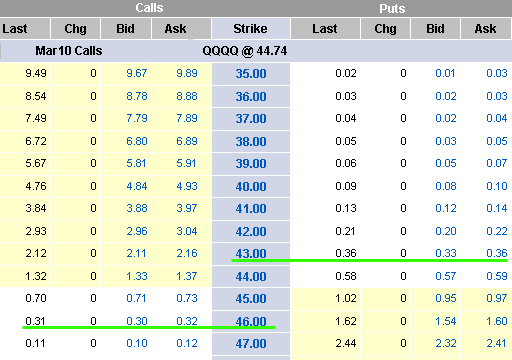Trading The QQQQ With InTheMoney Put Spreads
Post on: 16 Март, 2015 No Comment

Many traders who are new to trading options prefer to keep it simple, usually sticking to straight buying of puts or calls to match their market outlook. But moving from outright options buying and selling to spread trading is not as difficult as it may seem. Here we look at a trade that can be used for trading a bullish outlook with a limited risk options credit spread. which can be substituted for buying options. The position contains a significant statistical edge, as well as an overall lower risk profile.
Trading the QQQQ
To illustrate the above strategy, we will use the QQQQ (formerly the QQQ) as an example. The Qs, as they are commonly known, represent the ticker symbol for the Nasdaq-100 Trust, an ETF (exchange-traded fund) that tracks the Nasdaq 100 index. Traders can buy and sell the Qs if they want to trade the underlying Nasdaq 100 Index, much like futures traders trade futures contracts on the same index. Option traders, meanwhile, can trade the options on the QQQQ, and these options have exploded in volume since they were introduced. (For further reading on ETFs, see Introduction To Exchange-Traded Funds .)
Let’s say you believe that you have a medium-term bullish outlook on the market and would like to speculate on this view using options. One approach might be to simply buy two long-dated at-the-money options on the QQQQ, which would have a position delta of about 100 (or 1.00).
Suppose you decide you would like to buy two January 2006 at-the-money options to go long on the QQQQ. This would give you unlimited upside profit potential with limited risk on the downside. The QQQQ at the time of writing was trading at 39.10, with the at-the-money January calls selling for 1.60. Therefore, you would need to pay $320 ($160 each) for the two options. So, the maximum risk is $320 should the QQQQ trade lower, with upside breakeven at 40.60. Figure 1 presents the profit/loss profile of this trade.
Figure 1 — January 2006 at-the-money QQQQ 39 long calls.
Of course, one of the downsides to buying options is risk from time-value decay. This position would have a theta of $1.60 (measured here as a dollar value decline per day in the options value due to time decay) at the outset. Meanwhile, if the move never occurs, and the QQQQ heads lower, the loss of the entire premium paid for the options is possible. (To learn more about time value, see The Importance Of Time Value .)














